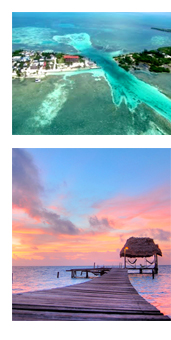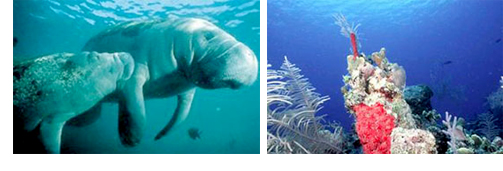La Isla Carinosa
Caye Caulker
Originally Caye Caulker was a five mile long “caye” (island) originally known by the Spanish as “Cayo Hicaco,” the “Island of the Coco plum.” The current name most likely was given to the island many years ago when ships were brought here to be careened and their leaky seams re-caulked by shipwrights, or “caulkers.”
In 1961 Hurricane Hattie swept through the Caribbean and divided the island in two, leaving a narrow waterway between the two islands; since then strong tidal forces have scoured it out into a wider, deeper swift moving channel called “The Split,” that separates old Caye Caulker into two sandy limestone coral islands.

North Caye Caulker and South Caye Caulker. The north is mostly undeveloped mangrove stands. The south, about two miles long, houses the town of about 800 Mestizo, Garifuna, and Creole residents.
The islands are on top of a limestone shelf; inside the limestone shelf are several still largely unexplored, huge underwater caves. In front of the village of Caye Caulker there is a fairly shallow lagoon, varying between 6 inches and 14 feet deep that extends out to the great coral Barrier Reef, a mile to the east. Directly in front of the village, the reef is known as a “dry reef” because it extends above the surface. Further north the top of the reef is about 8 feet under the waves that pass over it. This section of the reef is the Eastern portion of the Caye Caulker Marine Reserve.
The atmosphere at Caye Caulker varies from relaxing to just plain laid-back. The white sand streets, the slow-moving golf carts used for transportation, and the casual dress with no shoes invite little of the activity known to the outside world as “work.” The weather, usually quite pleasant year around, doesn’t help fuel a work ethic either.

Birding in Caye Caulker

For visitors interested in bird watching Caye Caulker is a delightful surprise; there are hundreds of species, many not seen on the mainland. On any given day you may see Black Catbirds, Cinnamon Hummingbirds, Green Aztec Parakeets, Rufous-necked Woodrails, Ringed Kingfishers or Tropical Mockingbirds, as well as Cormorants, Sandwich Terns, Solitary Sandpipers and Magnificent Frigate Birds, among many other exotic sea and shorebirds that abound along Caye Caulker’s shorelines and in the littoral forests and mangrove lagoons.
Snorkeling at Caye Caulker
Hard Corals, Gorgonians, Sea Fans, Tunicates, and shellfish of incredible variety abound in the warm Belize coastal waters; the prevalence of one in a particular stretch of reef often gives that area its name. Similarly, there are areas where Groupers, Large Stingrays, Mantas and Spotted Eagle Rays are fairly common. If fortunate you may encounter a Hammerhead Shark or Caribbean Reef Shark.
Photography: Even amateur photographers take great underwater photos here using disposable marine cameras. The cameras work in depths of up to nine feet, which is perfect for the shallow waters inside the reefs at the Hol Chan Marine Reserve and Shark-Ray Alley. (Your guides have these cameras available, ask before you go out.)

Hol Chan Marine Reserve
Hol Chan is Off the southern tip of Ambergris Caye, near Caye Caulker. (Hol Chan is the Mayan word for ‘little channel.’ This sea life sanctuary was officially established in 1987and since then the return of all species of fish has been dramatic.The reserve covers approximately three square miles and is divided ito three bouy marked zones. This popular underwater park accesible only by boat, is rich in marine life and in coral. The clear shallow water is ideal for snorkelers and divers who will swim with a varity of fish, stingrays and moray eels.Click here for more on Hol Chan Marine Reserve.

Shark-Ray Alley

For several years, local fishermen often stopped to clean their catch in this area. When they noticed that their activity was attracting Nurse Sharks and Southern Sting Rays, they told the dive operators in San Pedro, who went to investigate. “Shark-Ray Alley” soon became a popular dive site. Shark-Ray Alley is very popular for those who want to see sharks and rays up close and personal.
The creatures that live here have a great tolerance for divers and seem to enjoy interacting with humans. The Rays, which have a ‘wing-span’ of two to four feet, swim directly towards the divers, inviting them to reach out and stroke their wings (although it’s best not to touch them). Some swim in circles touching the divers, like a cat rubbing against their legs. It is a very strange feeling, having these creatures rub up against you. Once you get used to it you’re certain to have some of the best memories of your life.
Night Snorkeling
Night diving is popular, you will see a variety of nocturnal sea creatures that are completely different from those seen during the day and the colors are spectacular.
